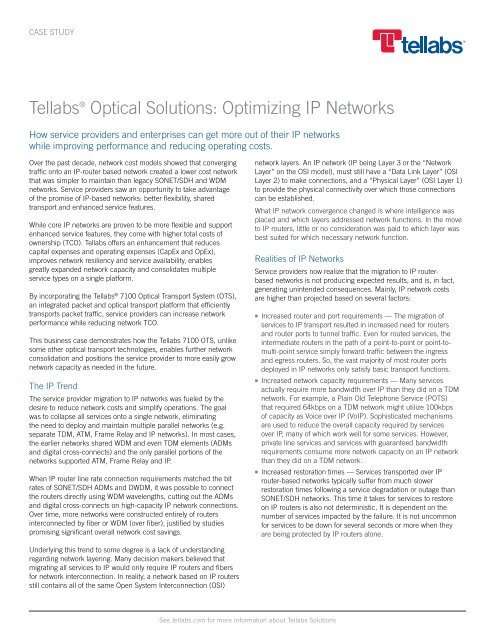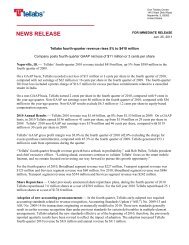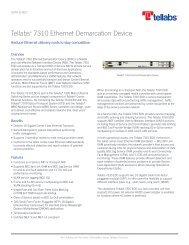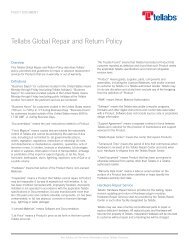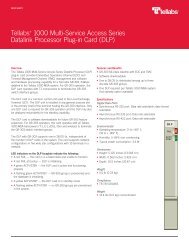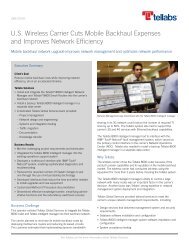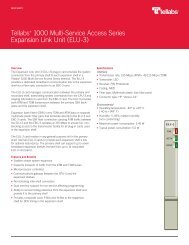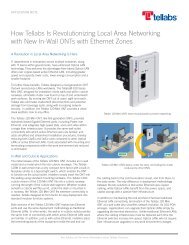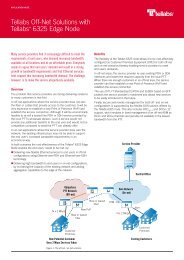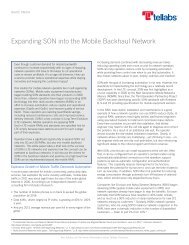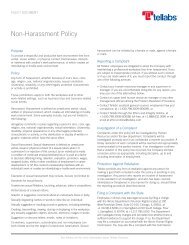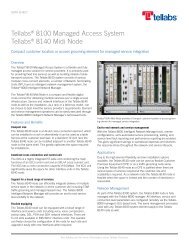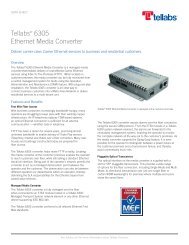Tellabs Optical Solutions: Optimizing IP Networks
Tellabs Optical Solutions: Optimizing IP Networks
Tellabs Optical Solutions: Optimizing IP Networks
You also want an ePaper? Increase the reach of your titles
YUMPU automatically turns print PDFs into web optimized ePapers that Google loves.
CASE STUDY<br />
<strong>Tellabs</strong> ® <strong>Optical</strong> <strong>Solutions</strong>: <strong>Optimizing</strong> <strong>IP</strong> <strong>Networks</strong><br />
How service providers and enterprises can get more out of their <strong>IP</strong> networks<br />
while improving performance and reducing operating costs.<br />
Over the past decade, network cost models showed that converging<br />
traffic onto an <strong>IP</strong>-router based network created a lower cost network<br />
that was simpler to maintain than legacy SONET/SDH and WDM<br />
networks. Service providers saw an opportunity to take advantage<br />
of the promise of <strong>IP</strong>-based networks: better flexibility, shared<br />
transport and enhanced service features.<br />
While core <strong>IP</strong> networks are proven to be more flexible and support<br />
enhanced service features, they come with higher total costs of<br />
ownership (TCO). <strong>Tellabs</strong> offers an enhancement that reduces<br />
capital expenses and operating expenses (CapEx and OpEx),<br />
improves network resiliency and service availability, enables<br />
greatly expanded network capacity and consolidates multiple<br />
service types on a single platform.<br />
By incorporating the <strong>Tellabs</strong> ® 7100 <strong>Optical</strong> Transport System (OTS),<br />
an integrated packet and optical transport platform that efficiently<br />
transports packet traffic, service providers can increase network<br />
performance while reducing network TCO.<br />
This business case demonstrates how the <strong>Tellabs</strong> 7100 OTS, unlike<br />
some other optical transport technologies, enables further network<br />
consolidation and positions the service provider to more easily grow<br />
network capacity as needed in the future.<br />
The <strong>IP</strong> Trend<br />
The service provider migration to <strong>IP</strong> networks was fueled by the<br />
desire to reduce network costs and simplify operations. The goal<br />
was to collapse all services onto a single network, eliminating<br />
the need to deploy and maintain multiple parallel networks (e.g.<br />
separate TDM, ATM, Frame Relay and <strong>IP</strong> networks). In most cases,<br />
the earlier networks shared WDM and even TDM elements (ADMs<br />
and digital cross-connects) and the only parallel portions of the<br />
networks supported ATM, Frame Relay and <strong>IP</strong>.<br />
When <strong>IP</strong> router line rate connection requirements matched the bit<br />
rates of SONET/SDH ADMs and DWDM, it was possible to connect<br />
the routers directly using WDM wavelengths, cutting out the ADMs<br />
and digital cross-connects on high-capacity <strong>IP</strong> network connections.<br />
Over time, more networks were constructed entirely of routers<br />
interconnected by fiber or WDM (over fiber), justified by studies<br />
promising significant overall network cost savings.<br />
network layers. An <strong>IP</strong> network (<strong>IP</strong> being Layer 3 or the “Network<br />
Layer” on the OSI model), must still have a “Data Link Layer” (OSI<br />
Layer 2) to make connections, and a “Physical Layer” (OSI Layer 1)<br />
to provide the physical connectivity over which those connections<br />
can be established.<br />
What <strong>IP</strong> network convergence changed is where intelligence was<br />
placed and which layers addressed network functions. In the move<br />
to <strong>IP</strong> routers, little or no consideration was paid to which layer was<br />
best suited for which necessary network function.<br />
Realities of <strong>IP</strong> <strong>Networks</strong><br />
Service providers now realize that the migration to <strong>IP</strong> routerbased<br />
networks is not producing expected results, and is, in fact,<br />
generating unintended consequences. Mainly, <strong>IP</strong> network costs<br />
are higher than projected based on several factors:<br />
Increased router and port requirements — The migration of<br />
services to <strong>IP</strong> transport resulted in increased need for routers<br />
and router ports to tunnel traffic. Even for routed services, the<br />
intermediate routers in the path of a point-to-point or point-tomulti-point<br />
service simply forward traffic between the ingress<br />
and egress routers. So, the vast majority of most router ports<br />
deployed in <strong>IP</strong> networks only satisfy basic transport functions.<br />
Increased network capacity requirements — Many services<br />
actually require more bandwidth over <strong>IP</strong> than they did on a TDM<br />
network. For example, a Plain Old Telephone Service (POTS)<br />
that required 64kbps on a TDM network might utilize 100kbps<br />
of capacity as Voice over <strong>IP</strong> (Vo<strong>IP</strong>). Sophisticated mechanisms<br />
are used to reduce the overall capacity required by services<br />
over <strong>IP</strong>, many of which work well for some services. However,<br />
private line services and services with guaranteed bandwidth<br />
requirements consume more network capacity on an <strong>IP</strong> network<br />
than they did on a TDM network.<br />
Increased restoration times — Services transported over <strong>IP</strong><br />
router-based networks typically suffer from much slower<br />
restoration times following a service degradation or outage than<br />
SONET/SDH networks. This time it takes for services to restore<br />
on <strong>IP</strong> routers is also not deterministic. It is dependent on the<br />
number of services impacted by the failure. It is not uncommon<br />
for services to be down for several seconds or more when they<br />
are being protected by <strong>IP</strong> routers alone.<br />
Underlying this trend to some degree is a lack of understanding<br />
regarding network layering. Many decision makers believed that<br />
migrating all services to <strong>IP</strong> would only require <strong>IP</strong> routers and fibers<br />
for network interconnection. In reality, a network based on <strong>IP</strong> routers<br />
still contains all of the same Open System Interconnection (OSI)<br />
See tellabs.com for more information about <strong>Tellabs</strong> <strong>Solutions</strong>
2 TELLABS OPTICAL SOLUTIONS: OPTIMIZING <strong>IP</strong> NETWORKS<br />
Higher Latency — Due to the higher processing requirements<br />
for <strong>IP</strong> packets, <strong>IP</strong> routers increase the time required for data<br />
to traverse a network, as compared to the Ethernet or optical<br />
switching systems. This increased latency is typically small relative<br />
to the time it takes signals to propagate over long distance optical<br />
fibers, though it is still significant to many business customers.<br />
Decreased redundancy — <strong>IP</strong> routers, initially designed for<br />
enterprise networks, were not built to the same set of stringent<br />
redundancy requirements of TDM and WDM equipment. As<br />
larger and larger routers were built, redundancy was achieved<br />
by using parallel routers. The result is the need for additional<br />
routers that require a high number of port cards simply for<br />
router interconnection.<br />
The <strong>Tellabs</strong> ® 7100 <strong>Optical</strong> Transport System<br />
Eases the All-<strong>IP</strong> Burden<br />
The <strong>Tellabs</strong> 7100 OTS addresses the limitations of <strong>IP</strong> networks by<br />
offloading <strong>IP</strong> traffic from routers that can be handled equally well<br />
from a functional perspective, and at a much lower cost, via Carrier<br />
Ethernet and optical facilities. Routers continue to handle Layer<br />
3 service features. However, many services can take advantage<br />
of the lower latency, faster switch times, and more deterministic<br />
performance gained by traversing the packet optical layers of the<br />
<strong>Tellabs</strong> 7100 OTS. In addition, services that continue to rely on the<br />
<strong>IP</strong> routers perform better due to lower utilization after other traffic<br />
is offloaded to the <strong>Tellabs</strong> 7100 OTS.<br />
Service provider traffic can be separated into different categories<br />
including private line traffic, <strong>IP</strong> business services and <strong>IP</strong> Internet<br />
traffic. Different network operators choose slightly different ways<br />
of categorizing and engineering traffic for optimal cost and<br />
performance characteristics. Not all of these traffic types require<br />
<strong>IP</strong> routing across the entire expanse of the carrier network and<br />
can benefit from the advantages of the <strong>Tellabs</strong> 7100 OTS packet<br />
optical solution.<br />
Transitioning traffic to <strong>Tellabs</strong> packet optical transport should not<br />
require changing already defined traffic categories. Rather, it’s best<br />
to determine which existing traffic types are best suited for routerbased<br />
transport and which traffic types can take advantage of<br />
packet optical transport.<br />
Global Multiservice Operator<br />
A global multiservice operator (GMO) has subscribers across<br />
Latin America, South America, and Europe, with presence in<br />
over 20 countries. The GMO had several strategic initiatives:<br />
Diversify revenue and streamline architectures to compensate for<br />
declines in wireline revenues with wireless, broadband and video<br />
Bundle and converge services: mobile, long distance, broadband,<br />
Internet and fixed line services<br />
Gain market share<br />
Increase revenues from video and data<br />
The GMO’s major challenge is managing Internet bandwidth growth<br />
in the core and improving resiliency. <strong>Tellabs</strong> proposed a solution<br />
after comparing costs of a core based on “<strong>IP</strong> Core” versus a core<br />
based on “<strong>Optical</strong> Ethernet.”<br />
The GMO’s existing core router network topology (see Figure 1) was<br />
inefficient with all traffic flowing through Layer 3 network elements<br />
(<strong>IP</strong> routers) even though best effort (Internet) traffic was basically<br />
point-to-point in nature (between the Access Switch Routers and<br />
the Internet Routers).<br />
Access Switch Routers<br />
SWC1<br />
SWC8<br />
Internet +<br />
<strong>IP</strong>VPN<br />
Core Routers<br />
Figure 1. High-level overview of existing GMO network topology with<br />
all traffic flowing through <strong>IP</strong> routers.<br />
Internet Routers<br />
<strong>Tellabs</strong> proposed an enhancement to the GMO’s network topology<br />
that incorporates the <strong>Tellabs</strong> 7100 OTS (see Figure 2).<br />
The transport functionality enabled to support <strong>IP</strong> router traffic over<br />
<strong>Tellabs</strong> packet optical solutions is somewhat dependent on the <strong>IP</strong><br />
router settings employed (e.g. protection mechanisms, congestion<br />
and degradation mechanisms, and hold-off timer settings). For the<br />
most part, the <strong>Tellabs</strong> packet optical solution looks like a transparent<br />
pipe to the (higher layer) <strong>IP</strong> routers. As a result, the routers operate<br />
as though they were directly connected.<br />
SWC1<br />
SWC8<br />
<strong>IP</strong>VPN<br />
Internet<br />
7100<br />
7100<br />
7100<br />
7100<br />
The following two examples illustrate the operational cost<br />
reduction and improved network performance using <strong>Tellabs</strong><br />
packet optical solutions.<br />
Figure 2. High-level overview of network architecture with the<br />
<strong>Tellabs</strong> 7100 OTS to increase resiliency and reduce operating costs.<br />
See tellabs.com for more information about <strong>Tellabs</strong> <strong>Solutions</strong>
3 TELLABS OPTICAL SOLUTIONS: OPTIMIZING <strong>IP</strong> NETWORKS<br />
The <strong>Tellabs</strong> architecture benefits are two-fold: increased resiliency<br />
and reduced cost.<br />
Resiliency is improved by providing high speed optical and Ethernet<br />
switching to restore traffic after lower layer network degradations<br />
and failures. <strong>IP</strong> VPN routed traffic is still handled by routers.<br />
Unrouted traffic is only transported on the <strong>Tellabs</strong> 7100 OTS.<br />
All traffic is protected using the <strong>Tellabs</strong> 7100 OTS transport<br />
protection options, greatly reducing the restoration time after<br />
failures as compared to transport through core routers alone.<br />
<strong>Tellabs</strong> proposed a phased approach to improving the enterprise<br />
network architecture. The first phase added the <strong>Tellabs</strong> 7100<br />
OTS for DWDM only to replace the individual links interconnecting<br />
the routers. This allows the connections to share capacity on<br />
a single pair of fibers with each connection utilizing a dedicated<br />
wavelength. Phase one provided full redundancy with a point-topoint<br />
DWDM application, but still required excess capacity (a full<br />
10G) between each Core Router and each Network Distribution<br />
Layer (NDL) Router.<br />
Costs are reduced with the new architecture by offloading Internet<br />
traffic to the lower-cost <strong>Tellabs</strong> 7100 OTS, as compared to routerbased<br />
transport. Because Internet traffic is transported instead<br />
of routed, the number of 10GE interfaces needed on routers is<br />
reduced, lowering overall required router capacity.<br />
Enterprise Network<br />
Logical connections<br />
between each Core<br />
Router and the<br />
Access Layer<br />
Top Level<br />
Architecture<br />
Network<br />
Core Layer<br />
7100 7100<br />
Right-sized<br />
connections from<br />
Core Routers to<br />
Layer 2 Switched<br />
Transport Network<br />
The <strong>Tellabs</strong> 7100 OTS packet optical solution is also beneficial for<br />
enterprises to reduce network costs and improve performance.<br />
Layer 2 Switched Transport Network<br />
The enterprise network in this case study consisted of a fully<br />
redundant <strong>IP</strong> and MPLS router architecture, interconnected by<br />
10Gbps links. These links were underutilized pipes that resulted<br />
in extra network costs such as high construction cost for adding<br />
new fiber links.<br />
The enterprise’s starting architecture utilizes <strong>IP</strong> routers with MPLS<br />
to manage the connections (Figure 3).<br />
Network<br />
Distribution<br />
Layer<br />
7100 7100 7100 7100 7100<br />
To Access Layer and End User Buildings<br />
Figure 2. High-level overview of the enterprise network utilizing<br />
<strong>Tellabs</strong> 7100 OTS to more efficiently transport traffic.<br />
The second phase of the <strong>Tellabs</strong> rollout migrated traffic from fixed<br />
10Gbps connections between routers to optimize connections using<br />
thernet in three steps (Figure 4):<br />
7100<br />
C<br />
1 C<br />
C<br />
1. Implement Layer 2 switching using <strong>Tellabs</strong> 7100 OTS integrated<br />
Ethernet service modules.<br />
2. Use 10Gbps Layer 2 network to aggregate traffic and switch to<br />
appropriate destinations, enabling the enterprise to:<br />
Control broadcast traffic through VLANs and virtual switches<br />
Reduce core router ports by only paying for actual bandwidth<br />
required<br />
Reduce the quantity of 10Gbps transponders in DWDM<br />
equipment, particularly at the core<br />
Create logical mesh without costly physical fiber connections<br />
Figure 3. High-level overview of the enterprise’s starting architecture<br />
with six network distribution layer locations.<br />
3. Optimize the NDL locations by pulling all traffic into the <strong>Tellabs</strong><br />
7100 OTS for significant economic savings (eliminating the need<br />
for the NDL routers). The resulting savings include:<br />
CapEx: Equipment, fiber construction, software<br />
OpEx: Installation, maintenance, provisioning, troubleshooting,<br />
power and space<br />
The result was an optimized network that took advantage of<br />
<strong>Tellabs</strong> integrated Ethernet and optical capabilities in the <strong>Tellabs</strong><br />
7100 OTS, to right-size the connection from the Core Routers all<br />
the way to the Access Layer.<br />
See tellabs.com for more information about <strong>Tellabs</strong> <strong>Solutions</strong>
4 TELLABS OPTICAL SOLUTIONS: OPTIMIZING <strong>IP</strong> NETWORKS<br />
<strong>Tellabs</strong> Solution Benefits<br />
The <strong>Tellabs</strong> optical transport solution for improving <strong>IP</strong> router-based<br />
networks has many benefits:<br />
CapEx Savings: Service providers can realize immediate CapEx<br />
savings by combining Layer 2 aggregation and optical transport<br />
to reduce the number of 10GE router ports. The result is lower<br />
router capacity requirements and significantly lower overall costs.<br />
Without Layer 2 switching, each 10GE link interconnects two<br />
router ports. With Layer 2 switching, 10GE between a router and<br />
a <strong>Tellabs</strong> 7100 OTS can be utilized by the actual capacity required<br />
to one or more routers. With Layer 2 functionality, the <strong>Tellabs</strong><br />
7100 OTS switches traffic based on VLANs, to connect traffic to<br />
the appropriate router port. In some cases, the <strong>Tellabs</strong> 7100 OTS<br />
can eliminate the need for aggregation routers where capacities<br />
are low and/or backhaul costs are low. The combined savings of<br />
reduced ports and gained router capacity using the <strong>Tellabs</strong> packet<br />
optical solution is often more than 50%.<br />
OpEx Savings: Operational savings can also be significant. The<br />
integration of functionality into fewer network elements simplifies<br />
network maintenance and reduces space requirements. This<br />
results in lower warranty, technical support and service costs.<br />
Power consumption is also reduced for operating network<br />
elements and maintaining HVAC environments. These ongoing<br />
cost savings should not be overlooked when comparing different<br />
architectural options.<br />
Integration Advantages: <strong>Tellabs</strong> 7100 OTS integrated ADM<br />
functionality and TDM switching enables further network<br />
consolidation. Traffic not already migrated to the <strong>IP</strong>/MPLS network<br />
can be carried through the same <strong>Tellabs</strong> 7100 OTS network,<br />
further reducing the need for legacy TDM network elements.<br />
Network Resiliency and Service Availability: When lower layer<br />
network degradations and failure between routers occur, the<br />
<strong>Tellabs</strong> 7100 OTS provides high speed optical and Ethernet<br />
switching to restore traffic. The same router connectivity (fully<br />
redundant without a single point of failure) is provided for Layer<br />
3 traffic, with reduced restoration times for outages between<br />
routers. Traffic that does not require Layer 3 functionality is also<br />
protected using the <strong>Tellabs</strong> 7100 OTS transport protection options.<br />
These greatly reduce the restoration time (down to below 50ms<br />
in some cases) after failures as compared to transport through<br />
the <strong>IP</strong> routers. The <strong>Tellabs</strong> solution provides more alternative<br />
routes for restoring traffic (using the ROADMs) beyond the simple<br />
redundancy offered by point-to-point connections, and costly<br />
dedicated router ports and capacity. This benefit results in higher<br />
service availability and fewer customer complaints, without the<br />
increased cost for the same benefit using routers.<br />
Future Growth: The <strong>Tellabs</strong> 7100 OTS provides nearly unlimited<br />
bandwidth expansion using the same platform. The service<br />
provider can immediately save CapEx upon installation.<br />
Incremental expansion costs are also minimized. The capacity<br />
on a given link can grow from 10Gbps up to 88 wavelengths of<br />
40Gbps each — enabling future expansion of the network.<br />
Committed to Service Providers and Network Operators<br />
<strong>Tellabs</strong> partners with service providers and network operators<br />
to investigate the benefits of using our packet optical solution for<br />
enhancing their <strong>IP</strong> networks. We can greatly ease your transition<br />
to a new network architecture and help you achieve the cost<br />
savings and improved network performance you desire. <strong>Tellabs</strong><br />
offers a wide range of network assessment, installation, and<br />
management services to help improve network efficiency and<br />
service performance.<br />
If you are interested in learning more about how the <strong>Tellabs</strong> packet<br />
optical solution can enhance your <strong>IP</strong> network, please contact your<br />
<strong>Tellabs</strong> sales representative for a more detailed presentation.<br />
Definitions:<br />
ADM: Add/Drop Multiplexer<br />
ATM: Asynchronous Transfer Mode<br />
DWDM: Dense Wave Division Multiplexing<br />
OSI: Open Systems Interconnection<br />
ROADM: Reconfigurable <strong>Optical</strong> Add/Drop Multiplexing<br />
TDM: Time Division Multiplexing<br />
WDM: Wavelength Division Multiplexing<br />
North America<br />
Asia Pacific<br />
<strong>Tellabs</strong><br />
3 Anson Road<br />
#14–01 Springleaf Tower<br />
Singapore 079909<br />
Republic of Singapore<br />
+65 6215 6411<br />
Fax: +65 6215 6422<br />
Europe, Middle East & Africa<br />
<strong>Tellabs</strong><br />
Abbey Place<br />
24–28 Easton Street<br />
High Wycombe, Bucks<br />
HP11 1NT<br />
United Kingdom<br />
+44 871 574 7000<br />
Fax: +44 871 574 7151<br />
Latin America & Caribbean<br />
<strong>Tellabs</strong><br />
Rua James Joule No. 92<br />
EDIFÍCIO PLAZA I<br />
São Paulo – SP<br />
04576-080<br />
Brasil<br />
+55 11 3572 6200<br />
Fax: +55 11 3572 6225<br />
<strong>Tellabs</strong><br />
One <strong>Tellabs</strong> Center<br />
1415 West Diehl Road<br />
Naperville, IL 60563<br />
U.S.A.<br />
+1 630 798 8800<br />
Fax: +1 630 798 2000<br />
The following trademarks and service marks are owned by <strong>Tellabs</strong> Operations, Inc., or its affiliates in the United States and/or in other countries: TELLABS ® , TELLABS and T symbol ® , T symbol ® , and SMARTCORE ® . Statements herein may contain<br />
projections or other forward-looking statements regarding future events, products, features, technology and resulting commercial or technological benefits and advantages. These statements are for discussion purposes only, are subject to change and are<br />
not to be construed as instructions, product specifications, guarantees or warranties. Actual results may differ materially. The information contained herein is not a commitment, promise or legal obligation to deliver any material, code, feature or functionality.<br />
It is intended to outline <strong>Tellabs</strong>’ general product direction. The development, release and timing of any material, code, feature or functionality described herein remains at <strong>Tellabs</strong>’ sole discretion.<br />
© 2011 <strong>Tellabs</strong>. All rights reserved. 74.2126E Rev. B 2/11


